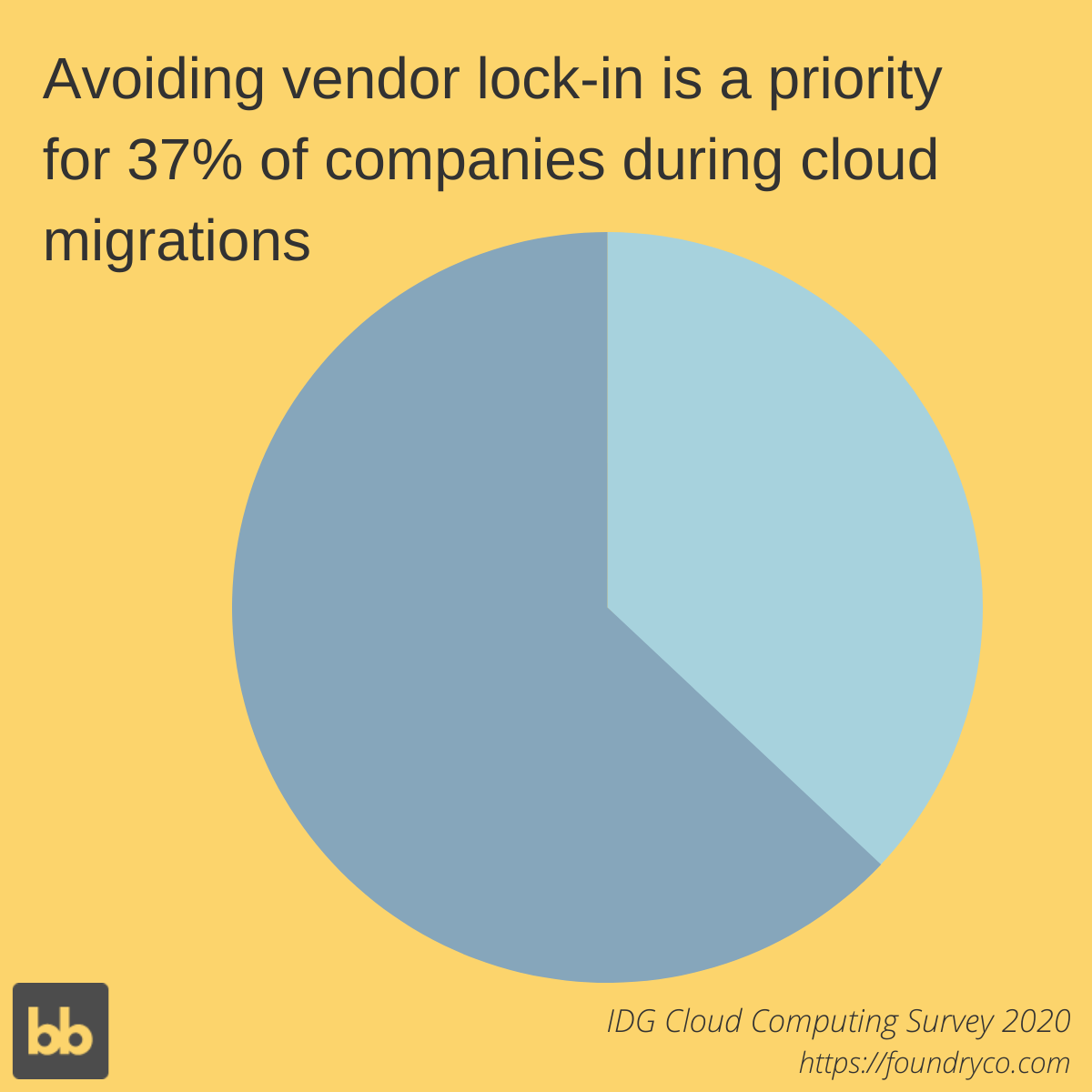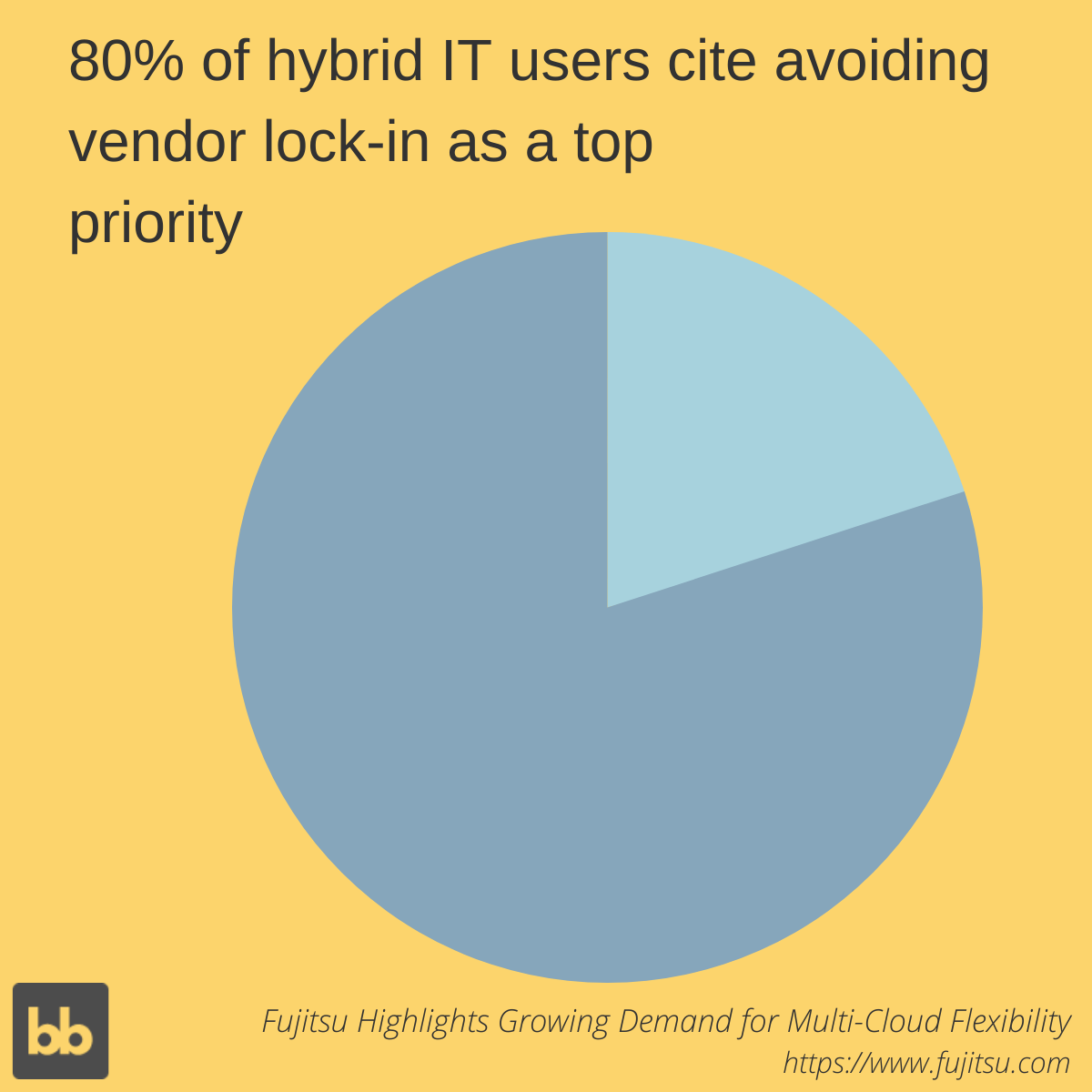What is Vendor Lock-in & How Do You Avoid It?
In large organizations, vendor lock-in is one of the key barriers to adopting newer, better technologies. This leaves you stuck using subpar tools, even when you know there are better solutions out there.
For example, you might decide that a tool no longer meets your needs, but the costs of upgrading it might simply be too high.
Of course, this is deeply frustrating. Lock-in also has serious consequences for your profitability, security, and operational efficiency,
According to IDG , avoiding, over a third of organizations cite avoiding vendor lock-in as a key decision factor when procuring new tools. The larger the organization, the bigger the concern about lock-in.

Today we’re going to cover everything your need to know about vendor lock-in, including how to avoid it and what to do when it occurs.
But first, let’s start with the basics.
What is vendor lock-in?
Vendor lock-in happens when the costs or disruption of upgrading a piece of technology outweigh the benefits. This means an organization is stuck with an ineffective tool because it would cost too much to replace or upgrade it.
Barriers here can be monetary, but they’re often also hidden costs, like service interruption, employee onboarding, contractual obligations, and migration risks. We’ll dive into this in more detail a little later.
Whatever the costs, organizations are locked into a vendor when decision-makers perceive the barriers to upgrading as too high. They’re then forced to continue using a product that doesn’t meet their needs.
Of course, vendors benefit greatly from lock-in, as users must continue to pay to use their product. In many cases, this is a deliberate part of their commercial strategy. Unscrupulous vendors may even seek to lock in users, before raising their costs.
In fact, many household names are known to have leveraged this strategy in the past.
How do companies get locked into a single vendor?
The key to understanding how vendor lock-in occurs is the tradeoff between costs and benefits of replacing systems. More specifically, it’s important to understand the different kinds of costs that organizations face.
Here are the key factors which lead to vendor lock-in.
Sunk costs
Sunk costs refer to what you’ve already spent on a platform. Depending on whether the platform in question is a custom build or an off-the-shelf tool, this could include development costs, licensing, subscription fees, or maintenance costs.
Excessive sunk costs make it difficult to gain executive buy-in for sourcing new tools. Decision-makers will often be reluctant to retire a system that they’ve already invested heavily in.
The flip side of this is that sunk costs are also indicative of the ongoing price of lock-in. That is, they reflect the price you’ll continue to pay to maintain or license an inadequate system.
As such, sunk costs can act as a barrier to upgrading your software stack, but they also highlight the need to do so.
Opportunity costs
Another key reason for vendor lock-in is the actual cost of replacing or upgrading systems. This includes the explicit cost of building or licensing a new tool. It also includes implicit costs, like time spent on tendering or procurement processes.
This can be a major concern in some scenarios. It might play a minimal role in others. Say you want to retire a legacy billing system. These days, there are countless alternatives out there, so it’s easy to find a tool that offers better results at a lower price.
As such, the opportunity costs are minimal.
Now say you rely on more of a niche tool that doesn’t have any direct competitors. Here, lock-in is more likely to occur, as your only alternative might be to build a custom solution to meet your needs, which carries higher explicit costs.
Contractual lock-in
Sometimes, organizations might find themselves locked into a particular vendor, because of the actual terms of their license. For example, you might have received a discount for agreeing to use the product for a set amount of time.
Or you might have signed up to pay support fees to a vendor for a fixed period. This creates lock-in, as you’re still required to meet these obligations, whether or not you’re actually using the product.
If you decided to replace these platforms, you’d effectively be paying for two systems. Of course, this is never going to be cost-effective.
Other kinds of contractual arrangements can also lead to vendor lock-in. For example, some partnership agreements or other corporate relationships might lead you to use a particular product, even when better alternatives exist.

Image credit: Scott Graham via Unsplash
Dependency and service interruption
Vendor lock-in is more likely to occur the more embedded a system in is your operations. If a tool is truly central to the way your business works, it can be very difficult to replace, even when it’s causing problems.
However, this kind of dependency further highlights the need to avoid lock-in, as you’ll be particularly vulnerable if something happens to the vendor.
Dependency also creates additional barriers to change. When a system is fully embedded in your operations, replacing it can be hugely disruptive. Without effective change management, this will quickly lead to lost revenue.
Migration risks
Moving to a new system always carries its own risks. Beyond service interruption, the key risk factors surround moving and reformatting data. This is especially difficult when dealing with older platforms, where data is often less portable.
Vendors might also use less common or poorly defined data models, making migration more difficult. Some vendors may also make it difficult to create your own backups, increasing the risks of migration.
For many organizations, the prospect of data loss is simply too great a risk, preventing them from moving to more effective software tools.
You might also like our guide to IT operations .
Internal resistance to change
Your internal culture can also facilitate vendor lock-in. A big part of this is resistance to change. Employees at all levels get used to certain ways of doing things. This applies to front-line staff, all the way up to the C-suite.
For example, employees might be reluctant to learn new systems. Executives might not be convinced of the need for change.
This can create a range of hidden costs, contributing to lock-in.
How does lock-in harm your organization?
Vendor lock-in almost always involves some combination of the factors outlined above. No matter the root cause, it can have several concrete impacts on your business.
Here are some of the key ways that vendor lock-in harms organizations.
You’re vulnerable to price hikes
When you’re locked into a particular vendor, there’s not much you can do about it if they decide to raise their prices. As long as the costs of changing systems outweigh the benefits, vendors can effectively charge you whatever they like.
Naturally, this is not a viable position to find yourself in.
Your needs might evolve and out-grow the product
Modern organizations must respond to constant change. Inevitably, this means that you’re going to need new features and functionality across your software stack. Vendor lock-in makes it difficult to be agile in the face of change.
For example, vendors might not implement the features you need quickly enough, or they might have no plans to support them at all. This leaves you stuck with outdated technology.
The vendor could end support
One of the most expensive consequences of lock-in is finding yourself dependent on a platform where the vendor has ended support. This creates unnecessary security vulnerabilities and the potential for service outage.
If a vendor ends support suddenly, you have several options, including legacy application modernization , bringing support and maintenance in-house, or paying for third-party support. However, all of these options can quickly lead to high costs.
Vendors can go out of business
It’s not uncommon for vendors to simply stop existing. Whether through insolvency, corporate buyouts, or simply disappearing into thin air, lock-in leaves organizations in a very difficult position if a vendor goes out of business.
Your options here are similar to when a vendor adds support, with the added challenge of needing to retrieve and back-up data, often at incredibly short notice.
The product may not be up to scratch
Lock-in can cause organizations to stick with solutions that are slow, dated, or insecure. In some cases, the product might never have really been fit for purpose. This can make it difficult to maintain competitiveness, because of internal inefficiencies in your organization.
Here, lock-in is a serious impediment to growth.
You don’t control your own data
Lock-in means settling for a vendor’s data models, even when they don’t suit your needs. For example, proprietary data standards will limit your ability to integrate with other tools. This also creates barriers to retrieving data when it’s time to move to a new system.
Again, vendor lock-in can also make it difficult to create and maintain backups of your own data, which can lead to countless problems.
How to avoid vendor lock-in: 6 tips
With such serious consequences, the best solution is to avoid vendor lock-in altogether. Here are some of the key ways you can avoid getting locked into a particular service provider.
1. Research the market
The better you know what solutions are out there, the easier it will be to avoid lock-in. Go into all conversations with vendors with a clear picture of how their platform stacks up against the competition.
This also means having a thorough understanding of how different solutions will work within your organization.
2. Understand your license
You must understand the fine print of your licensing agreements. In particular, you should look out for auto-renewal clauses, support arrangements, and any restrictions which might be imposed on you.
In particular, you’ll want to understand any limits the vendor might place on how you can access your data when the contract ends, and what happens if they can no longer support the product.
You should also think carefully about signing up for tools that come along with restrictive multi-year licenses unless you have complete confidence in the vendor.
3. Research your provider
It’s also crucial to thoroughly research potential software vendors. For example, you should be confident in their track record of responding to their users’ changing needs. They should show a clear commitment to meeting your evolving requirements.
One way to assess this is by assessing their reputation. Does the vendor have strong customer references from current and former users?
4. Have an exit plan
As part of the procurement process, you should be thinking about what happens when the time comes to retire your systems. Specifically, you should ask:
- What arrangements will the vendor put in place to assist with migrations?
- Who is responsible for creating back-ups?
- How will data be formatted?
- How and when can license agreements be ended?
The goal is to have a clear understanding of roles, responsibilities, and expectations when it comes to ending your relationship with the vendor. That way, you can begin planning systems retirement, well in advance of any change in circumstances.
5. Hybrid and multi-cloud solutions
Hybrid solutions involve using a combination of cloud-based and on-premises tools. A multi-cloud solution involves using tools across a range of different cloud-based vendors. The goal is to reduce dependency on a single vendor across your software stack.
Hybrid solutions offer the additional benefits of storing a proportion of your data on your own infrastructure. 80% of hybrid IT users do so to avoid vendor lock-in.

6. Consider open-source tools
Increasingly, businesses are turning to open-source solutions to avoid vendor lock-in. With open-source development platforms, like Budibase, organizations have greater control over the apps they use.
Because of the nature of open-source tools, vendor lock-in is highly unlikely.
With platforms like Budibase, organizations can build tools that fully meet their needs, and maintain and upgrade them as the need arises.
By using deployment tools like Kubernetes and Docker , open-source platforms can be deployed to a range of cloud-based and on-premises platforms, depending on your specific needs.
Mitigating the impact of lock-in with low-code tools
At Budibase, we’re changing the way businesses build software, forever. Using our open-source, low-code platform , you can build fully deployable tools in as little as five minutes.
We also offer support for a wide range of external data sources, third-party integrations , and hosting and deployment tools.
Budibase is completely shifting the cost-benefit calculation when it comes to building new tools. Check out our range of free app templates to find out more.